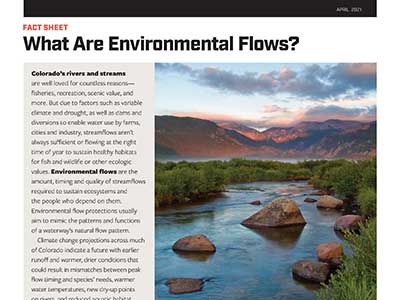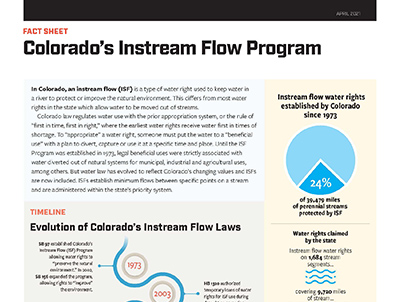Recreational & Environmental Water Use
River flows, aquatic and riparian habitat, water quality, bank stability, stream access, water temperature, and habitat connectivity are all critical factors to consider when determining environmental and river-based recreational needs.
Environmental and recreational water needs often overlap. Both environmental and recreational uses involve keeping water in streams and designating water for those specific uses. Water that supports a healthy environment needs to meet certain water quality standards and be of a sufficient quantity.
For example, the ability to keep a stream flowing can be beneficial for aquatic life as well as for anglers. In-stream structures that enhance boating experiences can also improve aquatic habitat for fish. In some cases, however, environmental and recreational water needs aren’t always compatible — for example, there may be different optimal flow levels for rafting versus fishing. Or, in recent summers when flows are low and water temperatures are high, the Yampa River through Steamboat Springs has been closed to recreational tubers and floaters to protect aquatic habitat and fish.
The 2023 Colorado Water Plan forecasts future challenges for Colorado’s environment. Climate projections indicate that in most parts of the state, streamflows could trend drier in the late summer months and peak runoff could shift as much as one month earlier, this could create a mismatch between peak flow timing and species’ needs. Drier late summer conditions could result in higher water temperatures and reduced habitat for fish. Temperature increases and more variable precipitation and runoff could also affect recreational boating.
There are various models and tools for managing water resources to protect the environment, species, and water users. These include through stream management plans (SMPs) and integrated water management plans (IWMPs), but also through focus area maps and a flow tool developed by the Colorado Water Conservation Board.
Stream Management Plans are voluntary, data-driven assessments used by communities to assess and address watershed health and mitigate future risk. Communities use data collected through these SMPs to prioritize how to protect or enhance environmental and recreational attributes in their watersheds.
Integrated Water Management Plans are similar to SMPs but include consumptive water uses like drinking water, irrigation, and energy production. They account for a wider array of needs and a larger group of stakeholders than SMPs.
The 2015 Colorado Water Plan set a goal of covering 80% of locally prioritized lists of rivers with stream management plans, and 80% of critical watersheds with watershed protection plans by 2030. This work helps communities understand local stream and watershed health, and to consider community needs and values, so they can prioritize how to protect and enhance environmental and recreational assets in their watershed. While the state’s 2023 update to the water plan no longer includes this numerical goal, it still encourages this work, and the goal did spur a lot of work on stream management plants. As of 2021, 26 stream management plants were completed or in progress in Colorado. Learn more about SMPs and IWMPs.


